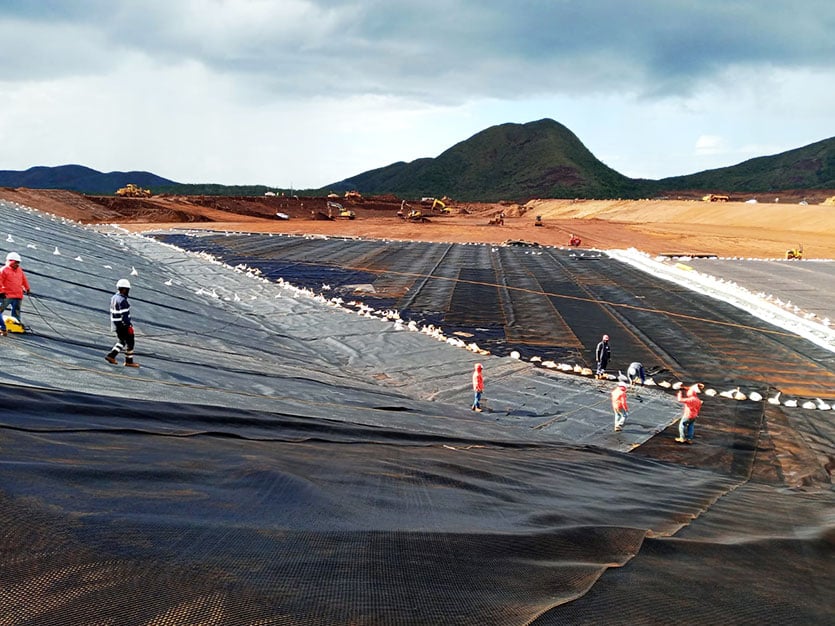What are Geosynthetics?
These are materials primarily made from petroleum-derived products, originally used in geotechnical engineering applications, designed to improve, alter, or maintain the characteristics of the soil they interact with. The polymeric nature of these products makes them suitable for use in soils where high levels of durability are required.
There is a wide variety of geosynthetic products that have been developed to serve different functions, and their use has been steadily increasing. This trend is expected to continue due to technological innovation and sustainability efforts. They are easy to prepare and transport, and can contribute to making construction projects more environmentally friendly.
Geosynthetics are divided into seven main product categories: geomembranes, geotextiles, geogrids, geonets, geocells, erosion control blankets, and geocomposites.

Types of Geosynthetics
There is a wide variety of geosynthetic products that have been developed to fulfill different functions, and the trend in their usage has been increasing and will continue to rise due to technological innovation and sustainability.
Geomembranes
Synthetic barriers of very low permeability, made from a thermoplastic polymer, primarily used for lining surfaces. Their main function is to contain materials and/or substances, preventing the flow of liquids and vapors out of it. Classification (by their main component).
- Polyethylene (HDPE, LLDP)
- Flexible Polyvinyl Chloride (F-PVC)
- Polypropylene (FPP, FPP-R)
- Ethylene Propylene Diene Terpolymer (EPDM, EPDM-R)
- Ethylene Interpolymer Alloy (EIA-R)
Composite
It's the combination of two or three geosynthetics (except GCLs, which are the combination of a geotextile with a natural material, expansive clay), which combine their multiple functions in their application.
- Geotextile - Geored
- Geotextile - Geogrid
- Geotextile - Geored - Geotextile
- Geotextile - Geored - Geomembrane
- Geotextile - Polystyrene core
- Geotextile - Flat tubular structure
- Geotextile - Expansive clay (GCLs)
- Geomembrane - Clay
Geotextiles
- Non-woven
- Woven
Geogrid
They are elements composed of filaments, which can be extruded (a single piece), woven, or welded, forming a mesh that, in combination with a filler element, provides tensile strength. Their function is to increase the load-bearing capacity of a terrain, achieved through the distribution of loads, resulting from the interaction or friction to which it is subjected.
- Uniaxial
- Biaxial
- Triaxial
Erosion control blankets
Also called 'erosion control blankets', they are systems for controlling surface erosion. Their sheet-like elements, of two or three dimensions, are used for storing organic material, which promotes vegetation, and this, in turn, serves to confine or contain the fines of a substrate.
- Degradable
- Biodegradable
- Permanent
Geonet
They are three-dimensional elements that in their structure present a hydraulic area, allowing the passage of fluid between two compressed or loaded strata.
Geocell
Three-dimensional structures, honeycomb-shaped, of high resistance, interconnected, and performing the function of confinement. Their function is to reinforce the soil by laterally confining the material particles and increasing its tensile strength, forming a rigid plate.
GCL Bentonite
The GCL (Geosynthetic Clay Liner) is an artificial hydraulic barrier with low hydraulic conductivity, self-sealing, and self-healing properties, composed of a layer of sodium bentonite supported between two layers of geotextiles or a geomembrane layer, bonded together by needling or chemical adhesives.
- Reinforced
- Unreinforced
Do you need samples? Contact us
We supply and install a wide range of geosynthetics. Each material is precisely selected and installed to meet strict environmental regulations, offering long term protection.
What are Geosynthetics Used For?
Usually, geosynthetics are produced with a specific purpose in mind, focusing on the key function they can perform. There are six main recognized functions, although some experts identify even more.
For proper classification and understanding, it is convenient to segment them as follows:
Separation
They prevent the mixing of two different strata or materials, avoiding contamination between them, thus preserving the physical and mechanical qualities of each.
Filtration
In the presence of water between two different strata or materials, it allows the passage of fluid, preventing the migration of fines or the mixing or contamination of particles between them, even when subjected to a load or compression work.
Drainage
It allows a flow regime between two strata, transporting fluids or gases through the plane of the geosynthetic, even when subjected to compression or loading work.
Reinforcement
The load-bearing capacity of a terrain is increased, resulting in a more stable surface. This is achieved through the distribution of loads, which is a result of the interaction or friction to which the geosynthetics are subjected.
Protection
Receive, absorb, and mitigate a force exerted on a surface against elements that may cause damage to it.
Waterproofing
An impermeable boundary or barrier is placed, isolating two different strata, preventing the impregnation of one with the other.
Specifications and Certifications of Geosynthetics
These may vary depending on the type of geosynthetic and its specific application.
Therefore, when selecting geosynthetics for a project, it is essential to consult the relevant specifications and regulations and work with trusted suppliers that offer products meeting the specific project requirements.
Some of the most common specifications and certifications used internationally for geosynthetics include:
- ASTM (American Society for Testing and Materials)
- ISO (International Organization for Standardization)
- GRI (Geosynthetic Research Institute)
- EN (European Norms)
- Manufacturer quality certifications
Do you have a project underway? Contact us.
We're the perfect ally to optimize your operation, guaranteeing efficiency and safety.
Additional Text
